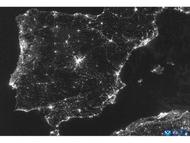Grid & Inertia - ORIGINAL CONTENT
- By:
- Edward A. Reid Jr.
- Posted On:
- Jul 14, 2025 at 6:00 AM
- Category
- Energy Policy, Climate Change
The recent blackout on the Iberian Peninsula was apparently triggered by an as yet unidentified “event” on the Spanish grid, which was being powered by approximately 70% renewable generation, mostly solar, which provides no inertia to the grid. It appears that the combination of conventional generation on the grid and the power provided by the interconnection to the French grid did not provide sufficient inertia to carry the grid through the “event” and the grid shut down when it exceeded either voltage or frequency tolerance limits.
This blackout has raised numerous questions about the stability and resilience of renewable powered grids. These questions include:
- Can a renewable plus storage grid operate reliably and stably?
- What is the maximum percentage of renewables consistent with reliability?
- Is there a maximum percentage of solar generation on a reliable grid?
- Is there a maximum percentage of wind generation on a reliable grid?
- Does a reliable grid require inertia; and, if so, how much?
- Is the physical location of the inertia sources on the grid important?
- What is the relative inertia contribution of steam turbines vs. gas turbines?
- What would be the inertia contributions of small modular nuclear generators?
- What is the effect of modulated output on inertia contribution?
- What effect does grid-scale storage have on inertia?
- Can inertia be effectively provided electronically?
The first question is the most fundamental. It cannot currently be answered based on observation, since there are currently no 100% renewable plus storage grids. Grid reliability concerns have continued to grow as the percentage of renewable generation on grids has increased. These concerns have been magnified as conventional generating capacity on these grids has been retired, reducing capacity reserve margins and inertial capacity.
The Spanish grid is one of the most renewable dependent grids. This blackout suggests that the Spanish grid might have reached or exceeded the maximum percentage of renewables or the maximum percentage of solar on the grid without the application of grid-forming inverters and expanded battery storage capacity.
Conventionally powered grids are powered by multiple steam and gas turbine generators which provide inertia. This inertia is frequently relied upon when there is a system “event” which affects voltage or frequency on the grid. Operation of renewable grids presents additional challenges, as both solar and wind generator output can transition rapidly from full rating plate capacity output to very low or zero output. Grid-scale battery storage can respond rapidly to changes in generator output, but its contribution to inertia is uncertain, especially since current grid-scale battery storage is very limited relative to the rating plate capacity of existing renewable generators.
It is likely that the location of either conventional generation or grid-scale battery storage capacity relative to the location of the “event” and the capacity of the grid between the inertia source and the disturbance “event” would affect the ability of the grid to survive the event. This might represent an advantage for the application of small modular nuclear generators as they would likely be located at a larger number of locations distributed throughout the grid service area.


